If you are anything like us, you probably enjoy spending time in the kitchen, experimenting with different foods and different recipes.
If this sounds like you, you will likely have come across at least a couple of dishes that require 1-2 lbs of chicken breast.
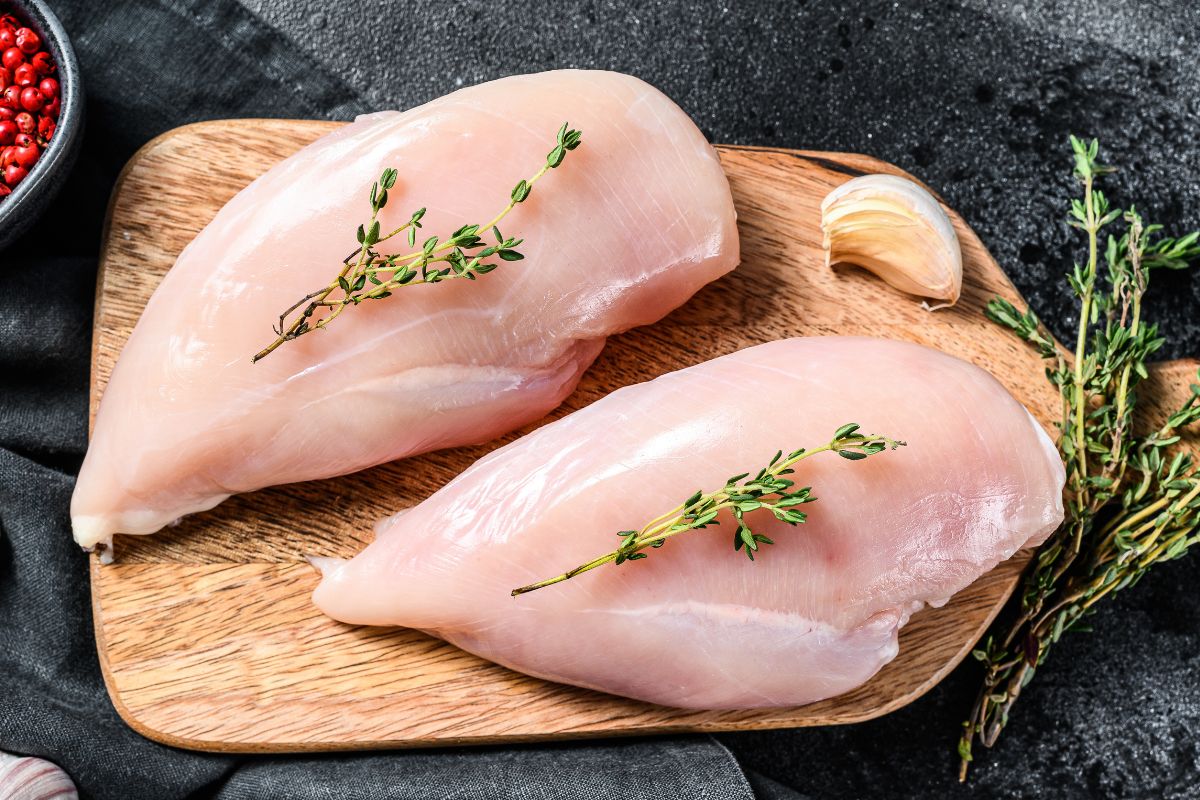
Which tends to lead us to wonder exactly how much chicken breast is in a pound.
Chicken is not often weighed in lbs, we are used to reading how many breasts to include, so when we see ‘lb’ we get very confused.
Chicken breast is one of the best meats to include in a healthy meal because lean white meats are less fatty.
Meals on diets, which often include this meat, require exact measurements, so you probably need to know how much an average chicken breast weighs as well!
Today we will try to answer every aspect of the question of how many chicken breasts are in a pound.
It should help you to prepare a whole variety of recipes that use chicken breasts. Of course, it also makes sense for us to talk to you about cooked and raw meat weight conversions too!
So, if you are a chicken lover and need to know more, stick around!
How Many Chicken Breasts In A Pound?
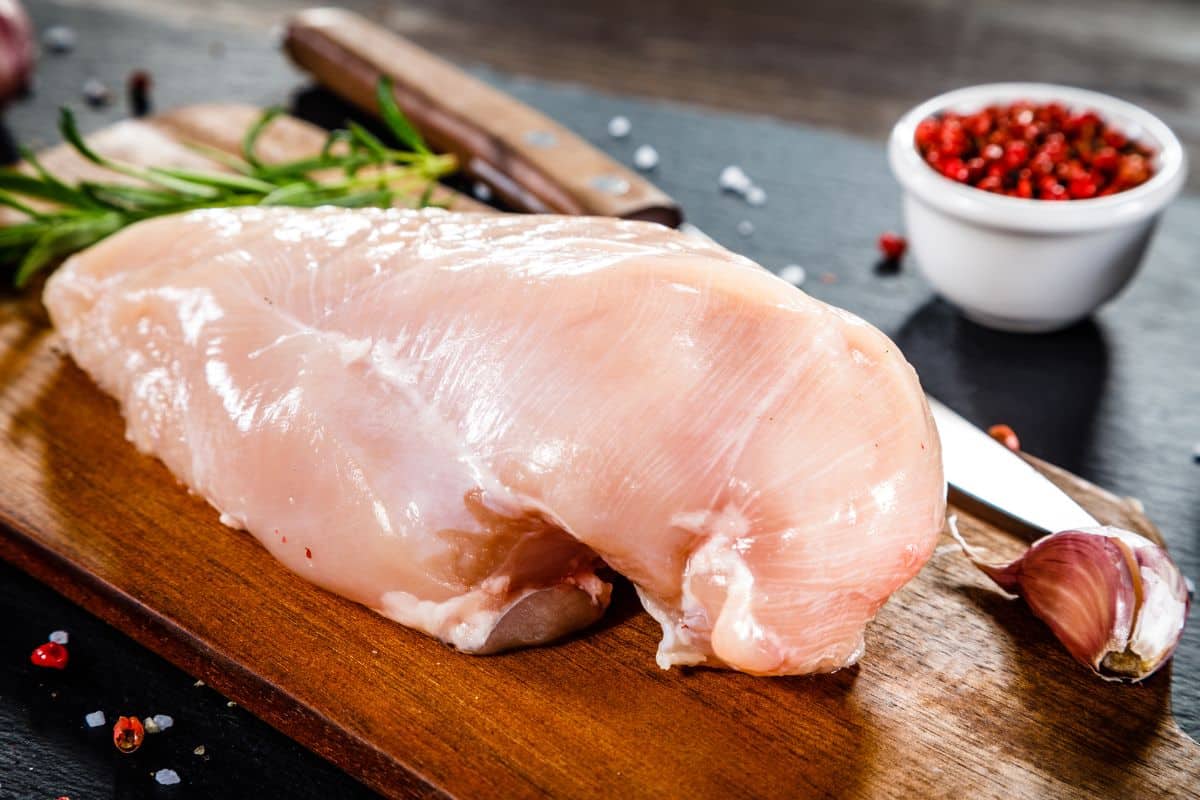
Let’s take a look at how many chicken breasts you need when you have a recipe that is asking for lb of chicken breasts, depending on if they are raw or cooked.
Raw Chicken
When dealing with chicken breast weight, a normal chicken breast will weigh around 3 to 8 oz when they are raw.
If you use this measurement for chicken breasts, then when you have average-size breasts you should use around 4 to make up a pound of chicken breasts!
This is a measurement specific to chicken breasts when raw, be they left whole or cut up into cubes.
Even more so, this is assuming that you are using typical chicken breast weight. So a single pound of single breasts would require 4 individual chicken breasts.
Cooked Chicken
Once the chicken has been cooked, the breasts do lose some water, so, you may need a bit more than you would if you weighed them when raw to reach a pound.
When a recipe asks you to use a pound of cooked chicken breasts, then use around 4.5 to 5 breasts.
Of course, it is still good practice to weigh each breast individually, so you can ensure you are getting as much as you think you are.
Chicken Breast Types
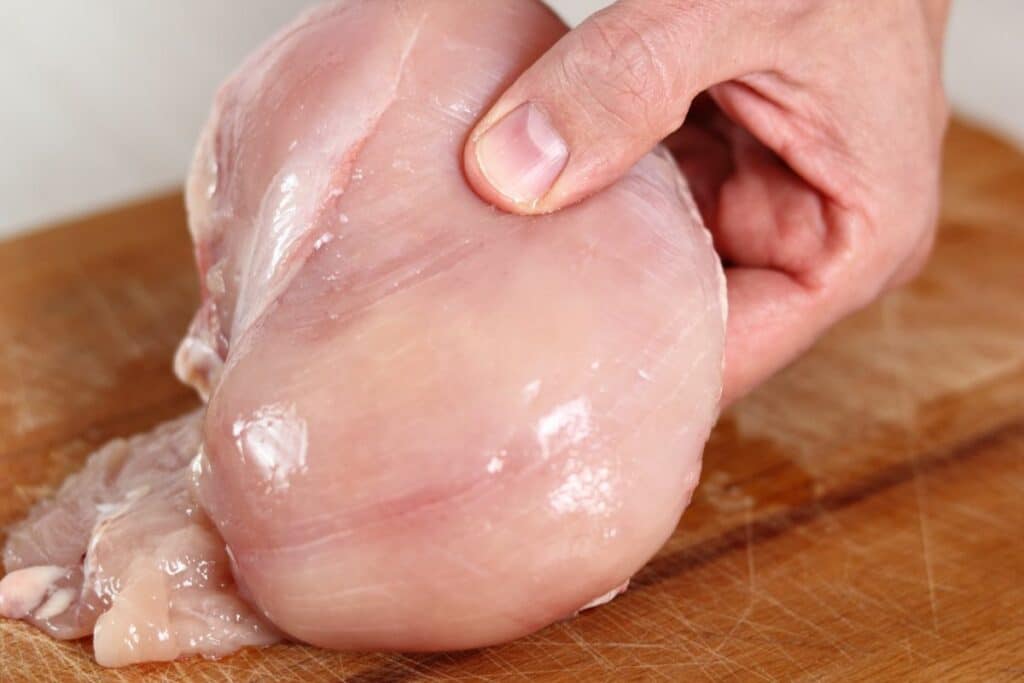
When it comes down to buying chicken breasts, there are a few options you have to choose from!
Let’s take a look at some of the most widely available types of chicken breasts you can choose from.
Chicken Breasts With Bone-In
Bone-in chicken breasts come with the bone still in the meat. Having the bone in the meat is not ideal for everyone, but it does help to keep the meat flavorful and moist as you cook it.
Bone-in breasts can take quite a while to cook in comparison to chicken breasts which do not have the bone in them.
That being said, a majority of people tend to prefer the texture and taste of bone-in breasts.
Boneless Chicken Breasts
As the name says, these chicken breasts have no bone, the bone has been removed.
This is a much more popular option for those who want a convenient and easy cut of meat that can be prepared in a wide variety of ways.
It is also very tasty, however, depending on how you cook it, it can dry out faster, so make sure you work to keep the meat moist as it cooks!
Chicken Breasts With Skin-on
Chicken breasts can be bought with the skin still on. Some people like the skin on the breast, but some do not primarily based on texture, however, leaving the skin on adds some amazing flavor!
Not only can it add plenty of flavors, but it also works to help keep the meat extra moist as it cooks. That being said, another reason it is not for everyone is that the skin does add extra fat and calories.
Chicken Breasts With No Skin
You can get chicken breasts with the skin already removed, this is a cleaner and healthier option. If you are watching your calorie intake, then this can be the best choice for you.
Organic
If you are mindful of the chemical influence of some chicken, then this is a good option for you. Organic chicken is free from hormones and antibiotics.
Organic chickens are raised on organic feed and have outdoor access, which makes the meat much more flavorful.
Regardless of the type of chicken breast you decide to choose, you always need to ensure that you are preparing and handling it safely to avoid any food-borne illnesses.
Be sure you are always cooking chicken to an internal temperature of no lower than 165 degrees Fahrenheit, and always use separate knives and cutting boards when preparing raw chicken in order to prevent any cross-contamination in your food prep.
Weight & Size
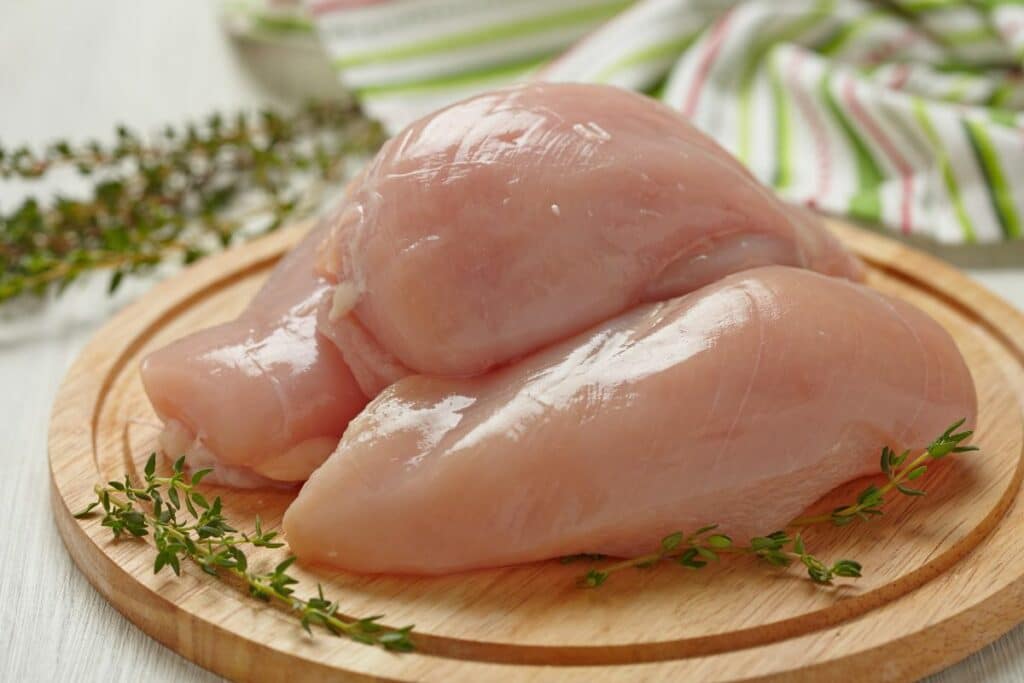
Are you curious about how the size of a chicken breast can affect the weight of the breast?
Well, if the weight of a chicken breast is 8 ounces, then it will be about the same size as 2 adult palms. Meanwhile, a chicken breast that is 4 ounces will be about the size of one palm.
8-ounce chicken breasts would fill a single cup when it is sliced up or cubed.
Be aware that we are using this scale for skinless, raw, and boneless chicken breasts.
Measuring chicken breasts as ounces is much better in comparison to measuring the number of cups to be used or the number of breasts. For one, it is much more accurate.
Let’s take a quick moment to look at the measurements versus their conversions for chicken breasts.
| Chicken Breasts Ounces | How Many Breasts? | How Many Cups? |
| 8 Oz | 2 | 1 |
| 16 Oz (1 lb) | 4 | 1.5 |
| 32 Oz (2 lbs) | 8 | 3 |
| 48 Oz (3 lbs) | 12 | 4.5 |
When you look at it this way, it does equate to basic math.
Let’s consider a few examples of how the number of breasts per pound can vary, though, as it is not always the same.
If you had 2 boneless, and skinless chicken breasts which weighed 6 ounces each, then you would have around 2.67 chicken breasts per pound.
However, if you had 2 bone-in chicken breasts, each weighing 12 ounces, there would be around 1.33 chicken breasts in each lb.
Alternatively, if you were to use organic chicken breasts, weighing 4 ounces, there would be around 4 chicken breasts in a pound!
Nutritional Information
Chicken breasts, especially the white meat, are a very common choice for people who are on low-fat, healthy diets also have a lot of protein, and without the fat, it is even better for you!
Chicken breasts can also be cooked in a variety of ways, and they won’t lose flavor.
A single chicken breast, which would weigh around 4 ounces total weight, will have a very healthy nutritional profile.
Let’s take a look at what you could expect from a 4-ounce chicken breast in nutrition:
| Nutrition | Amount |
| Calories | 284 k/cal |
| Protein | 53.4 grams |
| Carbs | 0 grams |
| Fat | 6.2 grams |
As a result, the chicken breast is an appropriate option for people who have a low-carb diet as there are no carbs in the chicken breast at all.
Chicken Breast Vs Chicken Thigh: Which Is Better For You?
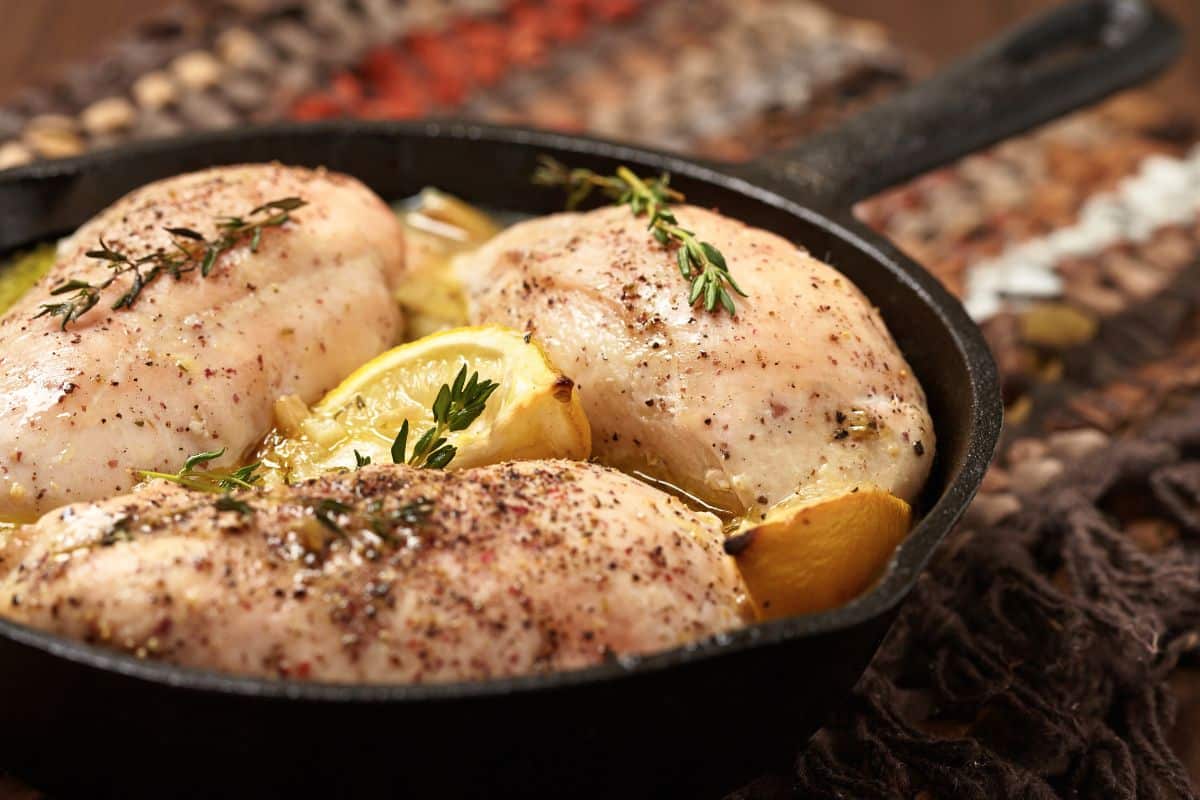
You might have noticed that chicken breasts are by far one of the healthiest parts of a chicken.
They are a part of the white meat. This meat has a higher level of protein, but low cholesterol and fewer saturated fats.
That being said, chicken thighs are usually more ideal for most, in terms of how affordable they are, and their taste.
Chicken thighs come with more moisture, making them much softer, and have a better taste.
But, we do need to ask if they are healthier, or even as healthy as a chicken breast is.
Well, chicken thighs that have the same weight as a chicken breast will have 3 times more fat, and a total of 201 calories.
Regarding fat, chicken breasts are definitely healthier, since they are leaner.
Trying to figure out the exact amounts of calories and nutrients is complex as cooking a dish with veggies and adding in oil can add to the calorific value.
However, the number of carbohydrates you get from a dish will often come from rice, potatoes, or bread.
Why Is Cooking To Temperature So Important With Chicken?
Chicken is one of the main things you need to be careful with when cooking.
You must always cook the chicken to the right temperature to ensure that you kill any and all harmful bacteria.
Cooking chicken to the right temperature will ensure that any bacteria or viruses that are present in the chicken are killed off.
Therefore, the recommended minimum temperature for chicken internally when cooked is around 165 degrees Fahrenheit, or 74 degrees Celsius.
The internal temperature that you use to measure chicken should be taken with a meat thermometer. This meat thermometer will ensure that the chicken has reached the optimal temperature and is safe to eat.
Chicken Related Food Safety
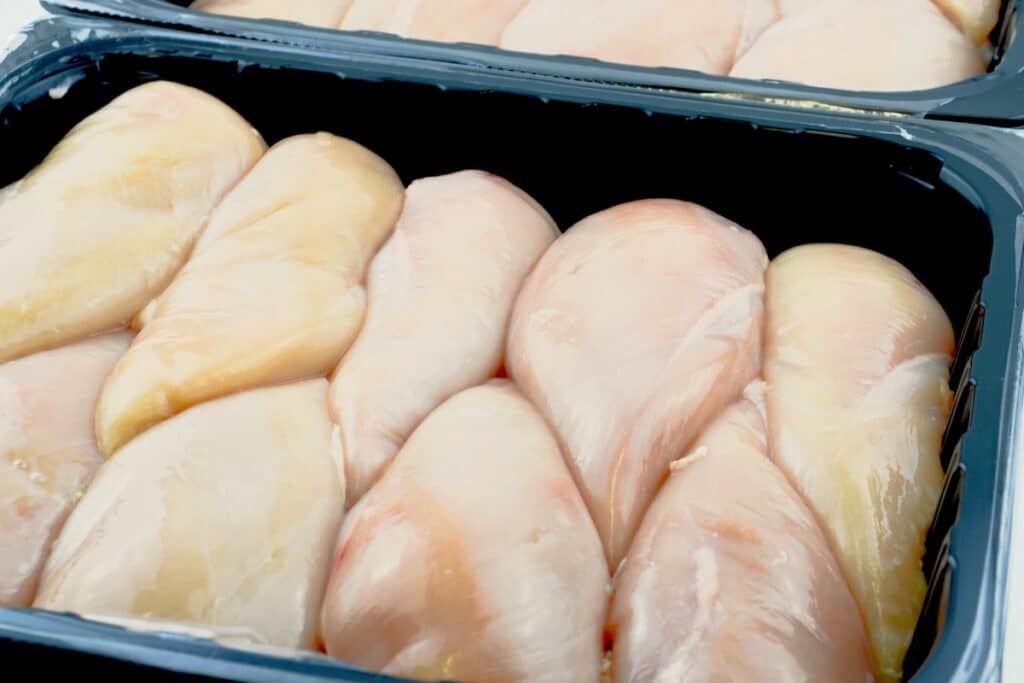
Aside from the cooking process with chicken, there are plenty of other things that you need to take into consideration when you are handling chicken, especially when raw.
So, let’s look through a few things you should be prioritizing in the kitchen.
Storage
It is pivotal that you safely store chicken to prevent any harmful bacteria from growing.
Chicken, when raw, should be stored at 40 degrees Fahrenheit, or 4 degrees Celsius, or lower to slow down any bacterial growth.
You should also always store your raw chicken in a sealed container on the bottom shelf of a refrigerator to prevent any drips from the chicken from contaminating any other food in the fridge.
Handling
Proper handling of chicken is very important in the prevention of cross-contamination. This can happen when the bacteria found on raw chicken comes into contact with another food.
To properly prevent this, you should always wash your hands with soap thoroughly before and after you handle raw chicken.
It is also for this reason that you should always use separate cutting boards and/or utensils for raw chicken, as well as other foods.
Thawing
The proper process of thawing chicken is essential in preventing harmful bacteria from growing.
The recommended ways that you can thaw chicken are in the refrigerator, with cold water, or in a microwave (although the microwave is not the best).
You should try to avoid thawing chicken at room temperature as it is possible that this can allow for the formation of and growth of bacteria.
Cooking
Properly cooking chicken is also very important in the goal of preventing any foodborne illnesses.
As we previously mentioned, the recommended minimum temperature (internally) is 165 Fahrenheit/ 74 Celsius.
You should always try to use a meat thermometer to check the temperature of the chicken internally.
Avoiding Undercooked Chicken
Undercooked chicken is susceptible to harboring bad bacteria that can cause illnesses.
Therefore, you must ensure the chicken is cooked to the correct temperature to kill bacteria that may still be present.
You should always double-check the internal chicken temperature using a proper meat thermometer to make sure it has properly reached the ideal temperature.
Overall
We hope that all this information has been helpful to you in all your catering endeavors.
Knowing how many chicken breasts there are per lb can make it much easier when you need to scale a recipe up or down.
Of course, knowing this, you can cook in bulk with ease, and cater to specific numbers of people without having to do any super lengthy calculations.
Understanding good kitchen hygiene when it comes to chicken is also pivotal as well!
And, remember if you are on a tight budget, don’t forget that chicken thighs are also available!
Frequently Asked Questions
Chickens have 2 breasts, over each side of the rib cage, on each side of the chest. Each of these two sides is called a chicken breast half. These tend to weigh 6 ounces each and are what we tend to know as a chicken breast filet.
8 chicken breasts will typically weigh around 2 pounds. Yet, this is not always the case, some chicken breasts may weigh less or more.
The best way to decrease a chicken breast’s cooking time is to cut through it, and down its length to create 2 thinner breasts.
This is known as butterfly cutting and helps the chicken cook much faster, as it is not as large.






